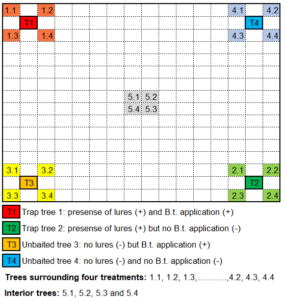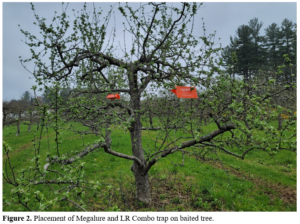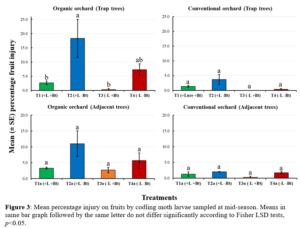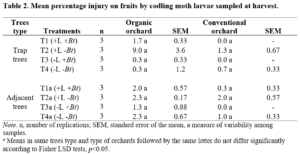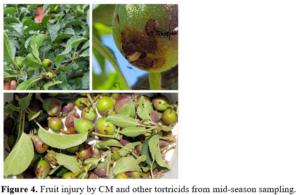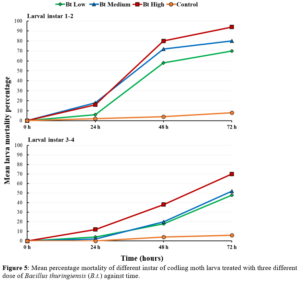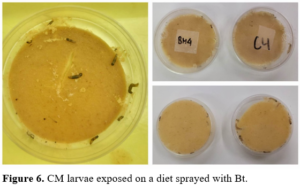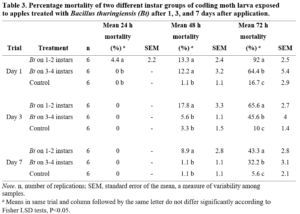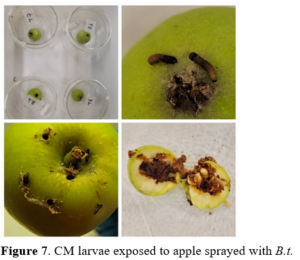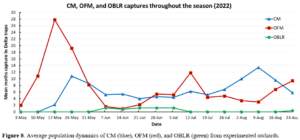Final report for GNE21-256
Project Information
Tortricid moths (Order: Lepidoptera) are economically damaging pest of apple trees. The main damage is caused by caterpillars, which bore into the fruit rendering the fruit unmarketable. Most apple growers in New England use synthetic insecticides to control caterpillars. Some small scale growers believe that there is a need for a management system that is eco-friendly as well as less expensive. To address this issue, we evaluated an environment friendly attract-and-kill system against codling moth (CM) and oriental fruit moth (OFM). We hypothesized that by strategically installing lures the pest will aggregate in specific areas within the orchard, giving us a chance to implement control measures on those areas, leaving other parts of orchard comparatively pest- and chemical- free. PHEROCON® Megalure CM 4K Dual lures and LR combo lures were used, and the information collected was used to set up a biofix for targeted application of the biopesticide, Bacillus thuringiensis (B.t. = Dipel). Our results show that trees baited with lure and not sprayed with B.t. had significantly higher fruit injuries (18.3%) caused by CM compared to trees baited with lure and B.t sprayed (2.7%), and trees without lure and B.t. sprayed (0.3%) during mid-season sampling. No injury by OFM was recorded on the field. The results from a lab study showed that B.t. applied at the label dose was effective at killing 94% of early instar codling moth larvae and its residue was still active after 7 days resulting in 43.3% mortality of early instar larvae. The results from this study suggest that the attract-and-kill system described here may be effective at managing codling moth in small orchards, and this approach should be evaluated further.
Objective 1 (field research): To evaluate the efficacy of an attract-and-kill strategy involving plant volatile-based lures and biopesticides to control major tortricid moths (codling moth, oriental fruit moth and obliquebanded leafroller) under field conditions.
Hypothesis: I hypothesize that by installing lures around the perimeter of the orchard will concentrate pest population within that area, so the rest of the orchard will have low pest pressure.
Objective 2 (laboratory research): To quantify the residual effect of commercially available B.t. product Dipel against the larval stage of three tortricid moths (codling moth, oriental fruit moth, and obliquebanded leafroller).
Hypothesis: I hypothesize that commercially available B.t. product will be effective in killing different instar larvae of of tortricids.
Objective 3 (Extension/outreach): To disseminate the findings of my research among commercial apple growers.
The purpose of this study was to investigate the applicability of an attract-and-kill system to manage codling moth, oriental fruit moth, and obliquebanded leafrolllers, which are important pests of apple and related fruit species, in apple orchards. A complementary study was conducted at laboratory to find out the field efficacy of commercially available B.t. against these pests.
Apple is one of the most valuable commodities in New England with approximately 13,600 acres producing 84,000 metric tons annually (NASS, USDA 2020). In eastern North America, apple orchards are often attacked by several insect pest species in the Lepidopteran family Tortricidae. Tortricid moths are notorious pests of pome (e.g., apple) and stone (e.g., peach) fruit because the immature stages (caterpillar) feed on leaves, shoots, buds, and fruits. Some common fruit pests of economic importance from this family are codling moth (Cydia pomonella) (CM), oriental fruit moth (Grapholita molesta) (OFM), and obliquebanded leafroller (Choristoneura rosaceana) (OBLR) (Lacey et al., 2007).
Two common management options used by growers to control tortricid pests are pesticide-based control and mating disruption. These control measures are mainly suitable for large scale conventional growers (Akotsen-Mensah et al., 2020; Orpet et al., 2020). However, applications of synthetic insecticide is detrimental to the environment and to non-target species and there is a growing evidence of pest resistance to various types of insecticides (Ioriatti and Lucchi, 2016; Wan et al., 2019). While the use of synthetic insecticide is not a suitable option for organic growers, mating disruption and biocontrol represent viable options for organic growers (Ioriatti and Lucchi, 2016).
The mating disruption technique utilizes sex pheromone to confuse male moths so that they are unable to find and mate with females. Mating disruption is generally appropriate for orchards with areas over 5-6 acres (Ioriatti and Lucchi, 2016). For smaller areas mating disruption may not work because mated females may immigrate into the orchard, will lay eggs, and the emerging caterpillars cause injury (Burks et al., 2020). For small scale growers this IPM method is logistically inapplicable and expensive. Therefore, we need to find an eco-friendly and cost-effective approach for these notorious pests.
Research
Insects: For laboratory experiments (objective 2), eggs of codling moth were bought from Benzon Research Inc. (Carlisle, PA). The larvae of codling moth were reared on artificial diet made for general noctuids. The larvae according to their larval instars were selected and were used to evaluate the residual effect of B.t. in laboratory.
Biopesticide: Bacillus thuringiensis var kurstaki was used in both field and laboratory experiment as a kill component. The commercially available B.t. product that was used in this study was DiPel.
Lures and traps: The plant volatile lure Pherocon® Megalure CM Dual 4K (a blend of four plant volatiles) (= Megalure) for codling moth and oriental fruit moth, and Pherocon® LR Combo Dual (= LR combo) for obliquebanded leafroller was purchased from Trécé Inc (Adair, OK). All lures were placed inside orange-colored delta-shaped traps (Pherocon VI, Trécé Inc.) with liners coated with adhesive.
Study 1: Attract-and-Kill of Tortricid Moths Using plant volatile-based lures: This study was conducted in six apple blocks across six orchards (Cold Spring Orchard in Belchertown, Agriculture Learning Center in Amherst, Plumbrook Farm in Amherst, Ragged Hill Orchard in West Brookfield, Red Apple Farm in Phillipston, and Breezeland Orchards in Warren) in Massachusetts. Of these, three orchards (X-block in Cold Spring Orchard, Agriculture Learning Center, and Plumbrook Farm) were certified organic apple blocks and received selected OMRI-listed materials. The other three orchards (Ragged Hill Orchard, Red Apple Farm, and Breezeland Orchards) received a standard insecticide spray regime against two key pests, plum curculio (PC) Conotrachelus nenuphar (Herbst) (Coleoptera: Curculionidae) and apple maggot fly (AMF), Rhagoletis pomonella (Walsh) (Diptera: Tephritidae). No insecticides were sprayed against any other insect pests.
In each apple blocks, trees were assigned one of the following four treatments: (1) presence of lures (+) and B.t. application (+), (2) presence of lures (+) but no B.t. application (-), (3) no lures (-) but B.t. application (+), and (4) no lures (-) and no B.t. application (-) (Figure 1). Each experimental tree was at least 50 meters apart from each other.
Figure 1: Experiment Design
The field study started in the first week of May 2022, with the installation of traps and lures. For codling moth and oriental fruit moth, dual species Megalure 4K (Trécé Inc.) lures were used, and for obliquebanded leafroller LR Combo (Trécé Inc.) lures were used. Each baited tree received one Megalure 4K trap and one LR Combo trap. These lures were hung on the inner side of the orange-colored delta shaped trap (Pherocon VI, Trécé Inc). Delta traps were suspended from the upper third of the tree canopy (Figure 2). Sticky liners were removed after the first capture of each moth species to prevent the further killing of moths in the traps. The moths collected from the first capture were examined under a dissecting microscope to determine their gender. Additionally, standard sex pheromone lure for codling moth, oriental fruit moth and obliquebanded leafroller were installed in a separate apple block inside all orchards to monitor the presence of moths. All the lures were replaced after every 4 weeks to insure the sustained flow of odor from the traps. Monitoring traps were checked weekly.
The information collected from monitoring trap was used to set up a biofix for all three species (CM, OFM and OBLR) (Table 1). The first continuous capture of moths was considered as biofix and based on that Biofix degree days were calculated to determine the egg hatch for each generation and time the B.t spray. For each moths B.t. was sprayed based on the biofix date and degree days model as shown in the Table 1 (“Northeast tree fruit management guide,” 2022; NEWA degree days calculator).
Apple trees were sprayed with B.t. using a backpack sprayer at the rate of 0.65 liter per tree (DiPel standard dose for pome fruits: 2.38 grams of DiPel per liter water) targeting both top and bottom part of leaves. Four adjacent trees were also sprayed to prevent the spillover effect of the traps. Injury data were collected mid-season (June 2022) and at harvest (August 2022). For each block, 100 fruits were visually inspected from each treatment tree (T1, T2, T3, and T4), 100 fruits from 4 adjacent trees (T1a, T2a, T3a, and T4a), 100 fruits from 4 interior trees, for a total of 900 fruits from each block. Across all 6 orchards, 5,400 fruits were visually inspected. All fruits that were suspected of having tortricid injury were brought to the laboratory and dissected for signs of tunneling and presence of larvae.
Study 2: Residual effect of commercially available B.t. product Dipel against the larval stage of codling moth: In this laboratory experiment, first we evaluated the dose response of B.t. against 2 different larval instar groups. The first group consisted of 1st and 2nd instar larvae that were 4 mm to 10 mm in length, and the second group consisted of 3rd and 4th instar larva that were 11 mm to 16 mm in length. The B.t. dose (treatments) used in this study were: ‘high’ dose at 2.38 gram per liter, ‘medium’ dose at 1.2 gram per liter, ‘low’ dose at 0.6 gram per liter, and control at 0 gram per liter. Ten codling moth larvae, of a given instar (either, 3-4 or 1-2 instars) were placed on a petri plate with artificial diet sprayed with a respective dose of B.t.. Each petri plate received 1 ml of the treatment solution that was sprayed from a hand atomizer. All treatments were placed in the growth chamber at 25°C, with 14:10 hour (light:dark) photoperiod, and a 47% relative humidity. Mortality data was taken at 24 hours, 48 hours, and 72 hours after exposure. The larvae that were completely dead (not moribund) are recorded as larval mortality in this study. By having two instar groups I was able to compare results cross instars.
To test the residual effect of B.t., immature apple fruits (1.5-2 cm in diameter) collected from the apple orchards were sprayed with B.t. at the standard dose (2.38 gram per liter). The sprayed apples were exposed to codling moth larvae on the same day of application (= fresh), day 3 after application, and day 7 after application. The treated apples for day 3 and day 7 were kept inside the growth chamber. A total of 15 CM larvae according to their larval instars were placed on each treatment. Mortality data was taken at 24 hours, 48 hours, and 72 hours after exposure. Similar to the above experiment, the larvae that were completely dead (not moribund) were recorded as larval mortality in this study.
Statistical analyses: For study 1, we calculated, the proportion of fruit that had codling moth larvae feeding injury out of 100 sampled fruits for each sampled tree. Data was converted to arc-sin prior to analyses. A preliminary analysis involved generalized linear mixed models assuming Poisson distribution, which compared the effects of “treatment” (fixed effect) and “orchard type” (Organic vs Conventional) and 2-way interaction among them. One-way analyses of variance (ANOVA) were conducted separately for mid-season sampling and harvest sampling, and for trap trees and adjacent trees to compare the average fruit injury. Fisher protected LSD tests at 5% probability level were used to compare the proportion of fruit injured by codling moth larvae.
Similarly for study 2, a preliminary analysis involved generalized linear mixed models which compared fixed effect (treatments) and random effects (larval instars for dose study and days for residual study) and 2-way interaction among them. Data were converted to arc-sin prior to analyses. One-way analyses of variance (ANOVA) were conducted separately, for dose study and residual study, to compare the average mortality percentage of larvae. Fisher protected LSD tests at 5% probability level were used to compare the percentage of codling moth larvae mortality.
Study 1: Attract-and-Kill of Tortricid Moths Using plant volatile-based lures.
In this study, during the mid-season sampling (June 2022), the mixed-model analysis revealed a significant interaction (ANOVA F3,3 = 3.26, p = 0.048) between treatment and orchard type for odor-baited trap trees but not for the adjacent trees. There was a significant difference (ANOVA F3,8 = 5.11, p = 0.028) across treatment in traps trees in the organic orchard. Trees baited with lure and not sprayed with B.t. [T2(+L -Bt)] had significantly higher levels of fruit injury (18.3%) compared to trees baited with lure and B.t sprayed [T1(+L +Bt)] (2.7%) and trees without lure and B.t. sprayed [T3(-L +Bt)] (0.3%), but were not significantly different than trees without lure and no B.t. sprayed [T4(-L -Bt)] (7.3%) during mid-season sampling (Figure 3). No significant differences were observed in conventional orchards across trap trees. This is partly due to the standard insecticide spray regime against other two key pests, plum curculio (PC), Conotrachelus nenuphar (Herbst) (Coleoptera: Curculionidae) and apple maggot fly (AMF), Rhagoletis pomonella (Walsh) (Diptera: Tephritidae) applied after petal fall. Those sprays were on top of the B.t. sprayed as part of this project. Similarly in adjacent trees, there was no significant differences in percentage of fruit injury in either organic or conventional orchards. In organic orchard adjacent trees, T2a(+L -Bt), had 11% fruit injury on average compared to 5.7% in T4a (-L -Bt) and 3.3% in T1a(+L +Bt). To identify the injury specific to moth species, we collected all the injured fruit and brought them to the lab for further inspection. Upon lab inspection of larvae and raising them in growth chamber, we concluded that all fruit injuries were caused by codling moth. We did not see any injuries by oriental fruit moths or obliquebanded leafrollers in this study.
In the harvest injury assessment (August 2022), we did not see any significant differences in fruit injury among treatments for trap trees and adjacent trees in both organic and conventional orchard (Table 2). Interestingly, biological differences were noted although the p-value (0.052) for organic orchard was marginal due to low statistical power. The reason for this might be fewer replications and also the fact that injured fruits are more likely to drop during June drop, resulting in fewer injured fruit at harvest, unless there is a fresh attack by later generation of moths. Trap trees, T2(+L -Bt), got 7.3% more fruit injury on average in organic orchard compared to T1(+L +Bt) just by not spraying B.t. on those trees. While comparing lure baited trap trees to its adjacent trees, it seems that injury is mostly aggregated to baited trees and there is less spillover effect of moths as shown by no significant differences in fruit injury in adjacent trees for both mid-season sampling and harvest sampling.
In sum, for study 1 trap trees baited with plant volatile based lures aggregated codling moth injury. By spraying B.t. to these baited trees, based on biofix and degree days model, fruit injury was significantly reduced. especially in organic orchards. We did not see any significant differences in conventional orchards partly due to the scheduled insecticide sprays for key pests. Overall, the fruit injury was below 2% at harvest in baited trees in conventional orchard, which is somewhat tolerable. These findings can help develop an attract-and-kill system especially for codling moth. Future studies should evaluate these findings on larger scales and test plant volatiles that are attractive to even more moth species.
Study 2: Residual effect of commercially available B.t. product Dipel against the larval stage of codling moth.
In the B.t. dose experiment (Figure 5), there were no significant differences in mortality at 24 hours for 1st and 2nd instar codling moth larvae (p=0.10), and for the 3rd and 4th instar codling moth larvae (p=0.05) across all treatments. At 48 hours there was a highly significant difference (p<0.0001) in mortality for both instar groups. B.t. at standard dose (here Bt High) had significantly higher mortality than B.t. at low dose (1/4th of standard dose) and control, but not different than B.t. at medium dose (1/2nd of standard dose) for 1st and 2nd instar larvae. The largest mortality (94%) was recorded at 72 hours for 1st and 2nd instar larvae in Bt High dose which was significantly different than any other treatments. There was no difference between Bt Medium and Bt Low at 72 hours. Similarly, for 3rd and 4th instar larva the largest mortality (70%) was recorded at 72 hours in Bt High which was significantly different than any other treatments.
For the B.t. residual study (Table 3), the mixed-model analysis revealed a significant interaction (ANOVA F4,5 = 3.83, p = 0.009) between fixed effect “treatment” and random effect “Days after B.t. application”. At 24 hours the only mortality recorded was on 1st and 2nd instar larvae which were exposed to apples sprayed with B.t. on day 1 (fresh). Note that we recorded mortality for the larvae that are completely dead. Some of the larvae stopped feeding and died after 48 or 72 hours. For B.t. to work, it should be ingested by the larvae so that the protoxin gets activated inside the midgut, being where the alkaline pH solubilizes the crystals which leads to cell swelling and lysis. At 48 hours there was no difference in mortality for 1-2 instars and 3-4 instars larvae for Day 1 fresh B.t. application. At 72 hours, the largest mortality (92%) was recorded in 1-2 instar larvae for Day 1 which was significantly different than the mortality of 3-4 instars larvae (64.4%). For Day 3 after B.t. application, the largest mortality (65.6%) was recorded in 1-2 instar larvae at 72 hours. And for Day 7 after B.t. application, largest mortality (43.3%) was observed again in 1-2 instar larvae. The mortality was decreasing as the days after application passed on for both larval instar groups. Since we were able to record 43.3% mortality on average of 1-2 instars and 32.2% mortality on average of 3-4 instars, we can say that B.t. residues were still present on the fruits after 7 days of application and was able to kill codling moth larvae.
For study 2, our findings show that B.t. applied at standard dose (2.38 gram per liter) was very effective at killing early and late instar larvae of codling moth. Our result also shows that B.t. residues were present in the fruits even after 7 days and were able to kill almost 50% codling moth larvae as compared to fresh material. Although we did not see mortality within the first 24 hours of exposure, the larvae were lethargic, had stopped feeding and they were expected to die but were not recorded as such. This study was conducted in laboratory conditions. Future studies should focus on field evaluation of B.t. residues.
Tortricid moth monitoring data:
Figure 8 shows the average population dynamics of codling moth (CM), oriental fruit moth (OFM), and obliquebanded leafroller (OBLR) in orchards under the study in 2022. OFM had 3 peak flights during the whole season which corresponds to three OFM generations. CM had 2 peak flights but had constant presence throughout the mid-season. OBLR was captured during mid-season, but its presence was far below thresholds.
The findings from this study will be helpful in developing an attract-and-kill system for codling moths. Our study indicates that:
- The tree baited with plant volatile based lure (in this study Megalure) can attract moths to the trap tree and can be killed by applying a toxic component (in this study Bacillus thuringiensis).
- t. is more effective against the early instar larvae as they are more likely to feed on fruits than late instars.
- t. applied at standard dose (2.38 gram per liter) can kill more than 90% of early instar larvae.
- t. residues were present in fruits (kept in growth chamber) after 7 days of B.t. application and were able to kill almost 50% larvae as that of fresh application.
Education & Outreach Activities and Participation Summary
Participation Summary:
- 1 Orchard walk and presentation at Massachusetts Fruit Grower Association Annual Summer Meeting, July 14, 2022, UMass Cold Spring Orchard. Total 94 participants.
- 1 Field Day and presentation with integrated pest management students on September 14, 2022 (Plum Brook farm, Amherst, MA). Total 17 participants.
- 1 Oral presentation on “Semiochemical based monitoring and management of Tortricid moths in Apple Orchard” in 84th Annual Northeast Tree Fruit IPM Workshop. October 24, 2022. Total 40 participants.
- 1 Oral presentation on “Semiochemical based monitoring and management of Tortricid moths in Apple Orchard” at the SSA Graduate Student Symposium, February 13, 2023. Total 32 participants.
- 2 Fruit Notes article will be published (1 summer issue and 1 in fall issue)
- 1 Abstract Submitted at the upcoming Annual Meeting of the Entomological Society of America 2023, National Harbor, MD.
Project Outcomes
This study satisfied critical needs regarding management of tortricid moths in apple orchards which in turn can bring promising outcomes for integrated pest management via integration of semiochemicals and biopesticides.
Short-term outcomes: Growers reached became aware of the benefits of using an attract-and-kill strategy for tortricid moths that integrates an inexpensive and effective biopesticide. Growers learned about the environmental and economic benefits associated with the IPM tool developed which could make codling moth management more effective.
Mid-term outcome: One grower from this SARE project has installed mating disruption techniques in his orchard and is using Megalure to monitor moths’ population and check the female moth immigration.
Through the execution of this research project, we learned that tortricid moths (codling moth) can be lured to a specific location in the orchard and can be killed using a bio control agent such as B.t. We also learned to use the degree days model to time the application of insecticide for different moth species.
From the grower conferences and field days, stakeholders (e.g., apple growers, Extension personals, students, and academic faculty) gained knowledge about the attract-and-kill system described here which may be effective at managing codling moth in small orchards.
